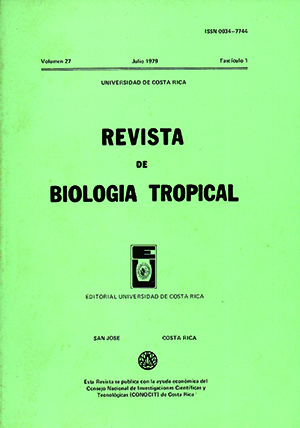Abstract
A community of 22 species of hummingbirds and over 45 species of omithophilous plants was studied over a seven-year period in the humid Caribbean lowlands of Costa Rica. There are two approximately equal peaks of blooming of hummingbird flowers in the year, during the dry season (March) and early in the rainy season (July-August); with a severe scarcity of flowers between November and January, at the end of the rainy season. The epiphytes of the forest canopy flower mainly in the dry season, understory plants mostly in the wet season, and at light gaps, edges, and in old second growth flowers are present year-round. Habitat shifts of hummingbirds are closely associated with flowering of preferred food plants, as is the differential habitat use by the sexes of some species. Migration of some species into and out of La Selva also reflects the cycle of flower abundance.
In general, the breeding seasons of the hummingbirds coincide with the first peak, and molting seasons With the second peak of flowering. Deviations from this pattern are few, and generally reflect the dependence of a given hummingbird upon a given flower species, or physiological mechanisms permitting molt-breeding overlap. The maximum body weight and fat reserves also occur during the second flowering peak, and both decline rapidly during the following season of flower scarcity. The low point in body weight occurs during this lean season, while the annual low of fat reserves comes in the following breeding season; another body component, probably muscle protein, must therefore be used as well as fat by the birds to survive the season of flower scarcity, when most of the annual mortality probably occurs.
Year-to-year variations in rainfall are considerable, but the hummingbirds are normally buffered from these by a series of compensatory phenological reactions among the plants that tend to maintain a regular, staggered sequence of flowering peaks. Nevertheless, a severe moisture stress, such as the drought of early 1973, may disrupt these patterns and have drastic effects on hummingbird populations.
References
Baker, H. G. 1963. Evolutionary mechanisms in pollination biology. Science, 139: 877-883.
Feinsinger, P. 1976. Organization of a tropical guild of nectarivorous birds. Eco!. Monogr., 46: 256-291.
Fogden, M. P. 1972. The seasonatity and population dynamics of tropical forest birds in Sarawak. Ibis, 114: 307-343.
Frankie, G. W., H. G. Baker, & P. A. Opler. 1974. Comparative phenological studies of trees in tropical wet and dry forests in the lowlands of Costa Rica. J. Ecol., 62: 881-919.
Hainsworth, F. R. & L. L. Wolf. 1972. Crop volume, nectar concentration, and hurnmingbird energetics. Comp. Biochem. Physiol., 42: 359-366.
Holdridge, L. R. 1967. Life Zone Ecology, 2a edición. Tropical Science Center, San José, Costa Rica.
Holdridge, L. R., W. C. Grenke, W. T. Hathaway, T. Liang, & J. A. Tosi. 1971. Forest environments in tropical tife zones: a pilot study. Pergarnon Press, Oxford.
Lack, D. 1968. Ecological adaptations for breeding in birds. Methuen, London.
Linhart, Y. B. 1973. Ecological and behavioral determinants of pollen dispersal in hurnmingbird-pollinated Heliconia. Amer. Nat. 107: 511-523.
Lofts, B., & R. K. Murton. 1968. Photoperiodic and physiological adaptations regulating avian breeding cycles, and their ecological significance. J. Zool. (Lond.), 155: 327-394.
Payne, R. B. 1973. Patterns and Control of molt, p. 103-155. In D. S. Farner y J. R. King (eds.). Avian Biology. v. 2, Academic Press. New York.
Petriceks, J. 1956. Plan de ordenación del bosque de Finca "La Selva", Tesis de maestría, U.C.A. Turrialba. Costa Rica.
Skutch, A. F. 1950. The nesting seasons of Central American birds in relation to climate and food supply. Ibis, 92: 185-222.
Skutch, A. F. 1975. The Life of the Hummingbird. Crown Publishers, New York.
Slud, P. 1960. The birds of Finca "La Selva", a tropical wet forest locality. Bull. Amer. Mus. Nat. Hist., 121: 49-148.
Snow, B. K. 1974. Lek behaviour and breeding of Guy's Hermit hummingbird. Ibis, 116: 278-297.
Snow, D. W., & B. K. Snow. 1964. Breeding seasons and annual cyc1es of Trinidad land-birds. Zoologica. 49: 1-39.
Snow, B. K., & D. W. Snow. 1972. Feeding niches of hummingbirds in a Trinidad valley. J . Anim. Ecol., 41: 471-485.
Stiles, F. G. 1973. Food supply and the annual cycle of the Anna Hummingbird. Univ. Calif. Publ. Zool., 97: 1-109.
Stiles, F. G. 1975. Ecology, flowering phenology, and hummingbird pollination of some Costa Rican Heliconia species. Ecology, 56: 285-301.
Stiles, F. G. 1977. Coadapted competitors: the flowering seasons of hummingbird-pollinated plants in a tropical forest. Science, 198: 1177-1178.
Stiles, F. G. 1978. Temporal organization of flowering among the hummingbird food plants of a tropical wet foresto Biotropica, 10: 194-210.
Stiles, F. G., & L. L. Wolf. 1973. Techniques for color-marking hummingbirds. Condor, 75: 244-245.
Stiles, F. G., & L. L. Wolf. 1974. A possible circannual molt rhythm in a tropical hummingbird. Amer. Nat., 108: 341-354.
Stiles, F. G., & L. L. Wolf. 1979. The ecology and evolution of lek mating behavior in the Long-tailed Hermit hummingbird. Monogr. Amer. Ornithol. Union, 27: en prensa.
Toledo, V. M. 1975. L a estacionalidad de flores utilizadas por los colibríes de una selva tropical húmeda en México. Biotropica 7: 63-70.
Ward, P. 1969. The annual cycle of the yellow-vented Bulbul Pycnonotus goiaveriri a humid equatorial environment. J. Zool.
Wolf, L. L., F. G. Stiles, & F. R. Hainsworth. 1976. Ecological organization of a tropical highland hummingbird community. J. Anim. Ecol., 32: 349-379.
Comments

This work is licensed under a Creative Commons Attribution 4.0 International License.
Copyright (c) 1979 Revista de Biología Tropical


